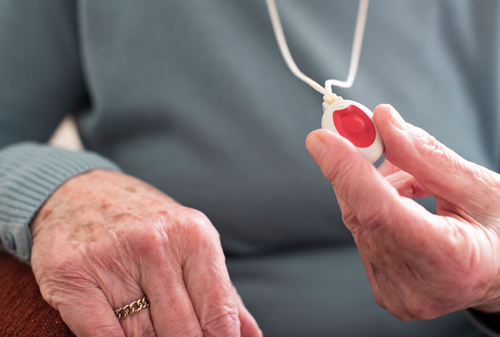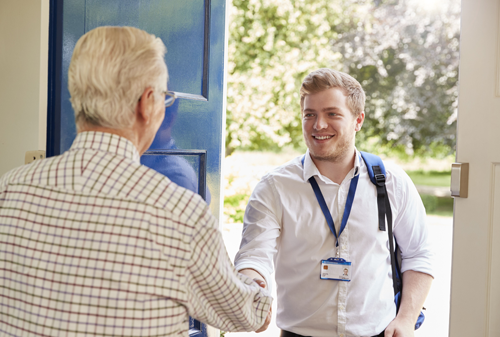




There has been a rapid growth in the electronic assistive technologies to monitor and respond to individuals at home or in a care setting, whilst supporting care givers in monitoring of large numbers of people.
Monitoring and response systems are used to check the health, well-being and safety of people living at home or in a care setting. This could be for short or long periods of time during the day or night. The main role and purpose of monitoring and response systems is to reduce the number of falls and hospital admissions, whilst increasing an individual’s autonomy and quality of life.
Getting the right support in place early may mean that an individual can continue to live in an environment of their choice.
There is a range of monitoring and response systems available. Most of these would be used to support elderly individuals or those with learning difficulties, dementia or behaviour that challenges. They include:
Bu twf cyflym yn y technolegau cynorthwyol electronig i fonitro ac ymateb i unigolion yn y cartref neu mewn lleoliad gofal, tra'n cefnogi'r rhai sy'n rhoi gofal wrth fonitro niferoedd mawr o bobl.
Defnyddir systemau monitro ac ymateb i wirio iechyd, llesiant a diogelwch pobl sy'n byw gartref neu mewn lleoliad gofal. Gallai hyn fod am gyfnodau byr neu hir o amser yn ystod y dydd neu'r nos. Prif rôl a phwrpas systemau monitro ac ymateb yw lleihau nifer y cwympiau a derbyniadau i'r ysbyty, tra'n gwella ymreolaeth ac ansawdd bywyd yr unigolyn.
Gall sicrhau bod y cymorth iawn ar gael yn gynnar olygu y gall unigolyn barhau i fyw mewn amgylchedd o'i ddewis.
Mae amrywiaeth o systemau monitro ac ymateb ar gael. Byddai’r rhan fwyaf o’r rhain yn cael eu defnyddio i gynorthwyo unigolion oedrannus neu’r rhai ag anawsterau dysgu, dementia neu ymddygiad a all fod yn heriol. Maent yn cynnwys:

Many monitoring and response systems work in collaboration with other services such as Local Authorities, Private Companies, Response Teams and Emergency Services.
Monitoring and response systems allow individuals to be linked up 24 hours a day to a central service that can offer help in an emergency. The link is usually either by telephone, a pull cord, a pendant worn around the neck, or a combination of these.
If the individual needs to summon help urgently and are unable to make a normal telephone call, they can use the pendant, pull the cord or use a special button on the telephone to contact a control centre.
This centre will be staffed by people who can talk to the individual, find out what they need and summon the appropriate help. In an emergency, the alarm operator gets in touch with the people the individual has agreed should be contacted in such circumstances; for example, a trusted relative or neighbour, who will have a set of keys to their home. The alarm operator also contacts the appropriate emergency service if this is required.
Some monitoring and response services can also provide a personal response service sending an appropriately trained member of staff to the individual’s home when an alert is raised, if they are unable to reach the individual’s contacts.
Monitoring and response services are usually available 24 hours a day, 7 days a week, every day of the year (including Bank Holidays).
Mae llawer o systemau monitro ac ymateb yn cydweithio â gwasanaethau eraill fel Awdurdodau Lleol, Cwmnïau Preifat, Timau Ymateb a Gwasanaethau Brys.
Mae systemau monitro ac ymateb yn caniatáu i unigolion fod â chyswllt 24 awr y dydd â gwasanaeth canolog a all gynnig help mewn argyfwng. Fel arfer mae'r cysylltiad naill ai dros y ffôn, gord tynnu, tlws crog wedi'i wisgo o gwmpas y gwddf, neu gyfuniad o'r rhain.
Os oes angen i'r unigolyn alw am help ar frys ac os nad yw'n gallu gwneud galwad ffôn arferol, gallant ddefnyddio'r tlws crog, tynnu'r cord neu ddefnyddio botwm arbennig ar y ffôn i gysylltu â chanolfan reoli.
Bydd y ganolfan hon yn cael ei staffio gan bobl a all siarad â'r unigolyn, cael gwybod beth sydd ei angen arnynt a galw am gymorth priodol. Mewn argyfwng, bydd gweithredydd larwm yn cysylltu â'r bobl y mae'r unigolyn wedi cytuno y dylid cysylltu â hwy o dan amgylchiadau o'r fath; er enghraifft, perthynas neu gymydog y mae posib ymddiried ynddynt, a fydd â set o allweddi i'w gartref. Mae'r swyddog larwm hefyd yn cysylltu â'r gwasanaeth brys priodol os oes angen.
Gall rhai gwasanaethau monitro ac ymateb hefyd ddarparu gwasanaeth ymateb personol sy'n anfon aelod o staff sydd wedi derbyn yr hyfforddiant priodol i gartref yr unigolyn pan godir rhybudd, os na allant gyrraedd cysylltiadau'r unigolyn.
Mae gwasanaethau monitro ac ymateb fel arfer ar gael 24 awr y dydd, 7 diwrnod yr wythnos, bob dydd o'r flwyddyn (gan gynnwys Gwyliau Banc).